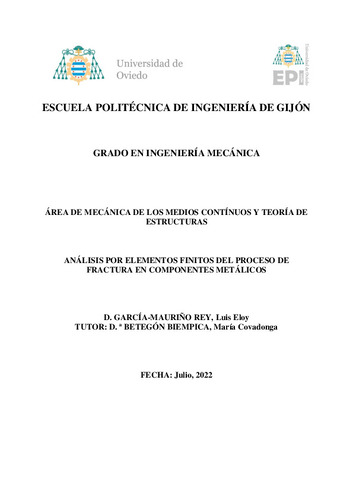Análisis por elementos finitos del proceso de fractura en componentes metálicos
Autor(es) y otros:
Director(es):
Fecha de publicación:
Serie:
Grado en Ingeniería Mecánica
Descripción física:
Resumen:
Se analizará la iniciación y la propagación del daño en componentes industriales por medio de un modelo que incorpora la física de la fractura en metales. Se utilizará el programa de elementos finitos Abaqus, junto con una subroutina de usuario en lenguaje Fortran (ya programada). Se analizarán varios casos de interés industrial donde el modelo virtual permitirá predecir la aparición de grietas y su propagación en función de las condiciones de carga. El trabajo se desarrollará en colaboración con investigadores del Imperial College de Londres.
Se analizará la iniciación y la propagación del daño en componentes industriales por medio de un modelo que incorpora la física de la fractura en metales. Se utilizará el programa de elementos finitos Abaqus, junto con una subroutina de usuario en lenguaje Fortran (ya programada). Se analizarán varios casos de interés industrial donde el modelo virtual permitirá predecir la aparición de grietas y su propagación en función de las condiciones de carga. El trabajo se desarrollará en colaboración con investigadores del Imperial College de Londres.
This paper is focused on the analysis of fracture mechanics in metallic materials through the finite element method. We shall use a software called Abaqus and subroutines that enhance it to experiment the plastic deformation process in a Small Punch Test (SPT) and compare it to experimental results. This study will take a deeper focus at the phenomenon known as strain gradient plasticity, which consists on the hardening experienced when considering the size effect on small specimens and it´s demonstration will be the main objective of this work. In order to do this, a model of the before mentioned SPT will be developed from scratch, an UMAT (User Material) subroutine will be implemented and the effect of size in stress-strain graphs will be evaluated and then compared it to experimental data obtained in the laboratory. This work consists of three theoretical chapters, one chapter focused in the simulation and the results obtained and a chapter on conclusions.
This paper is focused on the analysis of fracture mechanics in metallic materials through the finite element method. We shall use a software called Abaqus and subroutines that enhance it to experiment the plastic deformation process in a Small Punch Test (SPT) and compare it to experimental results. This study will take a deeper focus at the phenomenon known as strain gradient plasticity, which consists on the hardening experienced when considering the size effect on small specimens and it´s demonstration will be the main objective of this work. In order to do this, a model of the before mentioned SPT will be developed from scratch, an UMAT (User Material) subroutine will be implemented and the effect of size in stress-strain graphs will be evaluated and then compared it to experimental data obtained in the laboratory. This work consists of three theoretical chapters, one chapter focused in the simulation and the results obtained and a chapter on conclusions.
Colecciones
- Trabajos Fin de Grado [2090]
Ficheros en el ítem





